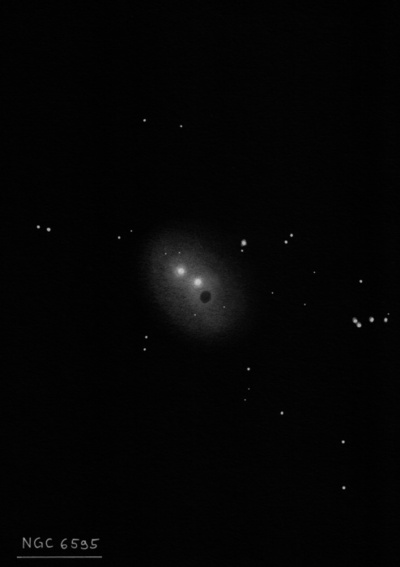
John Herschel discovered NGC 6595 = h2002 on 14 Jul 1830 and recorded "a double * h2827, involved in a pB large nebula 50". See description of that star." He reobserved this object the next two nights as well as sketched it. The RA was only measured on one sweep, but his position and description clearly apply to the bright RN surrounding the double star h2827.
Lewis Swift independently found this reflection nebula on 12 Jul 1885, though his position for Sw. II-62 = NGC 6590 was 45 seconds of RA too far west. Barnard also mentioned that the central star (BD -19°4946) was densely nebulous in AN 4239 and the nebula also received the designation IC 4700. Dreyer missed the equivalence with the previous NGC identifications, but NGC 6590 = NGC 6595 = IC 4700 (see NGC 6590 for more).
Sky Catalogue 2000.0 labels the nebula as NGC 6590/6595 and NGC 6595 is also catalogued as an open cluster at the same position (from Lynga). The RNGC has an error in declination, placing NGC 6590/6595 9' too far south.
300/350mm - 13" (7/16/82): moderately bright, small, surrounds a closely matched double star.
400/500mm - 17.5" (8/18/01): at 100x, this reflection nebula appears as a bright, round glow surrounding a similar pair (h2827) of 10th magnitude stars separated by 20". The glow is fairly large, extending roughly 4' in diameter. Forms a similar pair of RN with NGC 6589 6' NNW. The entire field is weakly glowing and this nebulosity is connected to the large region IC 1283/84 to the NE. A dark patch or globule on the NW side was not seen with certainty.
17.5" (6/20/87): at 88x with UHC filter appears as a bright, prominent nebulosity surrounding a pair of mag 10 stars. Similar or slightly larger than NGC 6589 in field 7' NNW.
Notes by Steve Gottlieb